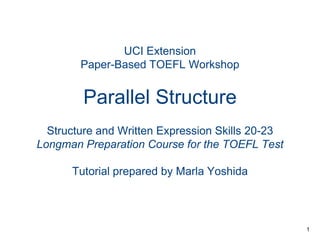
Skills 24 26 parallel structure
- 1. UCI Extension Paper-Based TOEFL Workshop Parallel Structure Structure and Written Expression Skills 20-23 Longman Preparation Course for the TOEFL Test Tutorial prepared by Marla Yoshida 1
- 2. Parallel structure • What does parallel mean? In math, two lines that are exactly the same distance apart all along their lengths are parallel. Parallel lines: • In grammar, two things are parallel if they are the same grammatically: Dogs and cats make good pets. (Both are nouns.) We went to the library and borrowed a book. (Both are verbs in the past tense.) 2
- 3. Parallel structure • In English, in some situations we need parallel structure. That is, two things have to be the same type of word or the same form. These sentences use correct parallel structure: The doctor is kind, caring, and intelligent. adjective adjective adjective (All the same—good!) You need to go to the DMV and get a driver’s license. verb verb (Both the same—good!) • These sentences don’t use correct parallel structure. They incorrectly link two different kinds of things: The doctor is kind, caring, and a pediatrician. adjective adjective noun (Not the same—incorrect) You need to go to the DMV and getting a driver’s license. verb verb+ing (Not the same—incorrect!) 3
- 4. Parallel structure with coordinate conjunctions • We can use coordinate conjunctions (especially and, but, or) to join two or more things. All the things have to be the same kind—all nouns, all past tense verbs, all infinitives, all clauses, etc. • We can join two nouns: Students will need paper and a pencil in every class. Either a pen or a pencil will be fine. • We can join two verbs (with the same form): You should go to the library and study. Have you read the book or seen the movie? (It’s OK not to repeat “have.”) I took piano lessons but didn’t practice often. (It’s OK if one has a negative and the other doesn’t.) 4
- 5. Parallel structure with coordinate conjunctions • We can join two adjectives: The Grand Canyon is beautiful and impressive. Do you want to see a movie that’s funny or sad? The story was sad but inspiring. • We can join two phrases: We can eat lunch at home or in a restaurant. There’s junk on the floor, under the bed, and on the chair. • We can join two clauses: The children are playing, and their parents are watching. Do you study because you want to or because you have to? What he says and what he does are two different things. I’d like to go to Europe, but I can’t afford it. • Be sure the things you join are grammatically the same. 5
- 6. Parallel structure with paired conjunctions • Paired conjunctions are two conjunctions that work together in a pair. These are: both… and… either… or… neither… nor… not only… but also… • With paired conjunctions, be careful of two things: 1. Use both halves of the pair together. Don’t mix up pairs. Correct: He not only cooked dinner, but also washed the dishes. (Good. Not only and but also fit together.) Incorrect: He not only cooked dinner, and washed the dishes. (Not so good. Not only goes with but also, not and.) 6
- 7. Parallel structure with paired conjunctions 2. Use the same kind of word or structure after both parts of the pair. Correct: I neither know what he wants nor want to find out. (Good. Know and want are both present tense verbs.) Incorrect: I neither know what he wants nor he told me. (Not so good. Know is a verb, but he told me is a clause.) 7
- 8. Parallel structure with comparisons • We can make comparisons in several ways. Here are some expressions that we can use: Showing a difference: more ADJECTIVE than… ADJECTIVE-er than… less ADJECTIVE than… Showing a similarity: as ADJECTIVE as… the same as… similar to… • Be sure to use the same type of word before and after the comparison expression. Elephants are bigger than mice. I think chemistry is more interesting than math. Living at home is less expensive than living in a hotel. To have friends is more important than to be rich. What I did on the weekend was the same as what you did. 8
- 9. Parallel structure with comparisons • Some comparisons seem almost right, but the comparison isn’t logical. For example, in this sentence, we want to compare the population of California with the population of Nevada. The population of California is bigger than Nevada. But that’s not what the sentence is actually saying. It’s comparing the population of California (a number) with the whole state of Nevada (a place). Instead, we should say: The population of California is bigger than the population of Nevada. OR The population of California is bigger than that of Nevada. (That is a pronoun that replaces the population.) Now we’re comparing a number with a number. Good. 9
- 10. Parallel structure with comparisons • Here’s another example. What’s wrong with this sentence? The flowers in my garden are as beautiful as the flower shop. • We’re comparing flowers with the flower shop. It’s better to say: The flowers in my garden are as beautiful as the flowers in the flower shop. OR The flowers in my garden are as beautiful as those in the flower shop. People sometimes do say sentences like some of the incorrect examples given here, but they’re not accepted on the TOEFL or in formal writing. • Skill 19 and Skills 27-29 also give information about using comparisons correctly. 10
- 11. Summary In this section, you have learned about these things: • It’s important to use parallel structure in certain situations: • With coordinate conjunctions • With paired conjunctions • With comparisons 11
